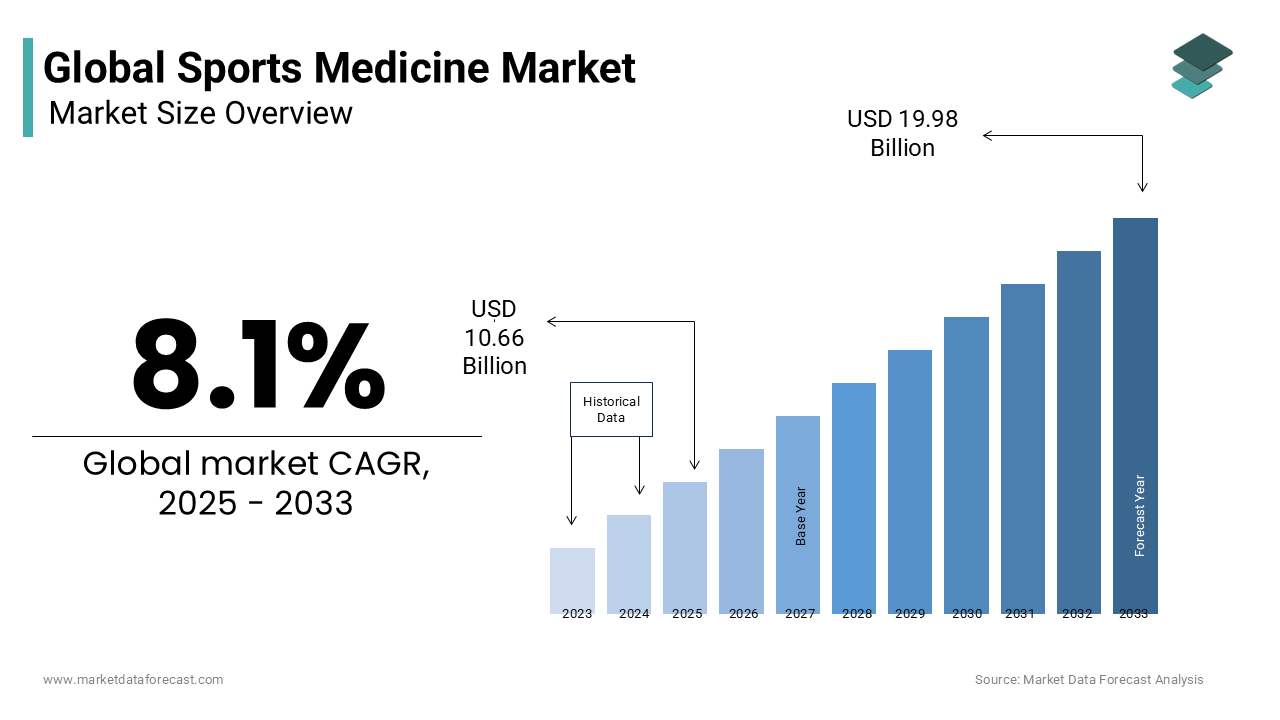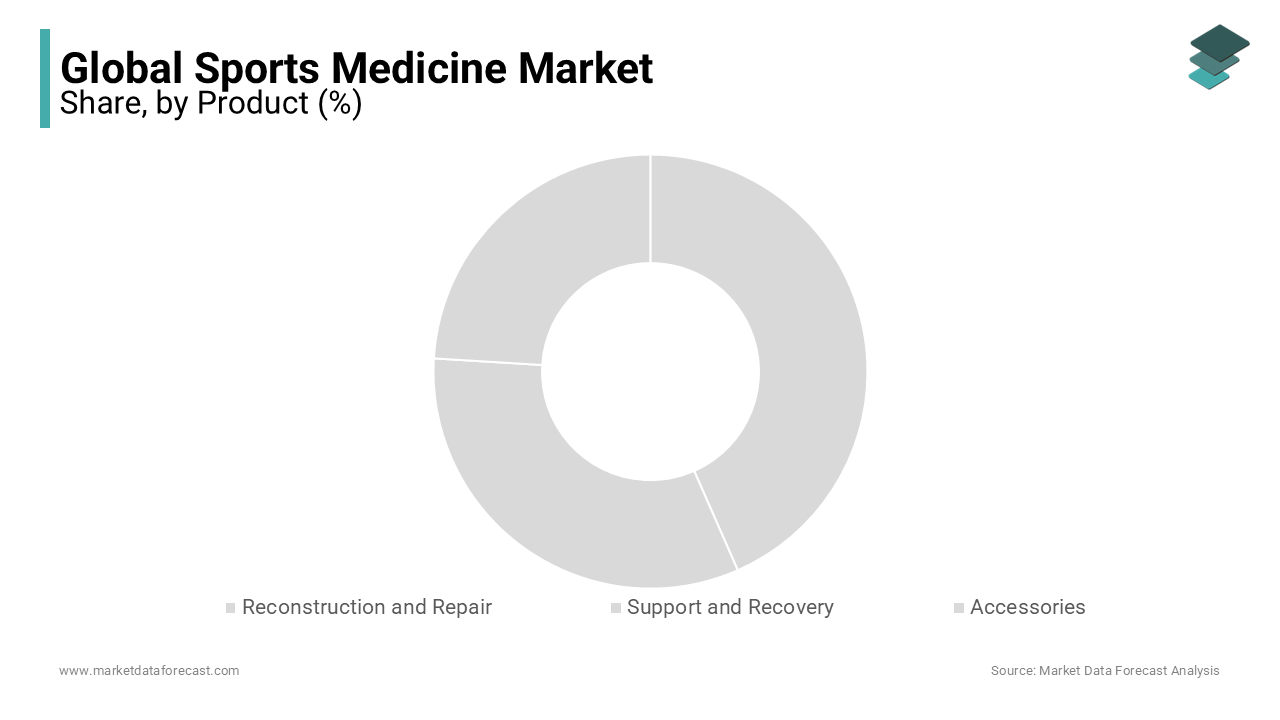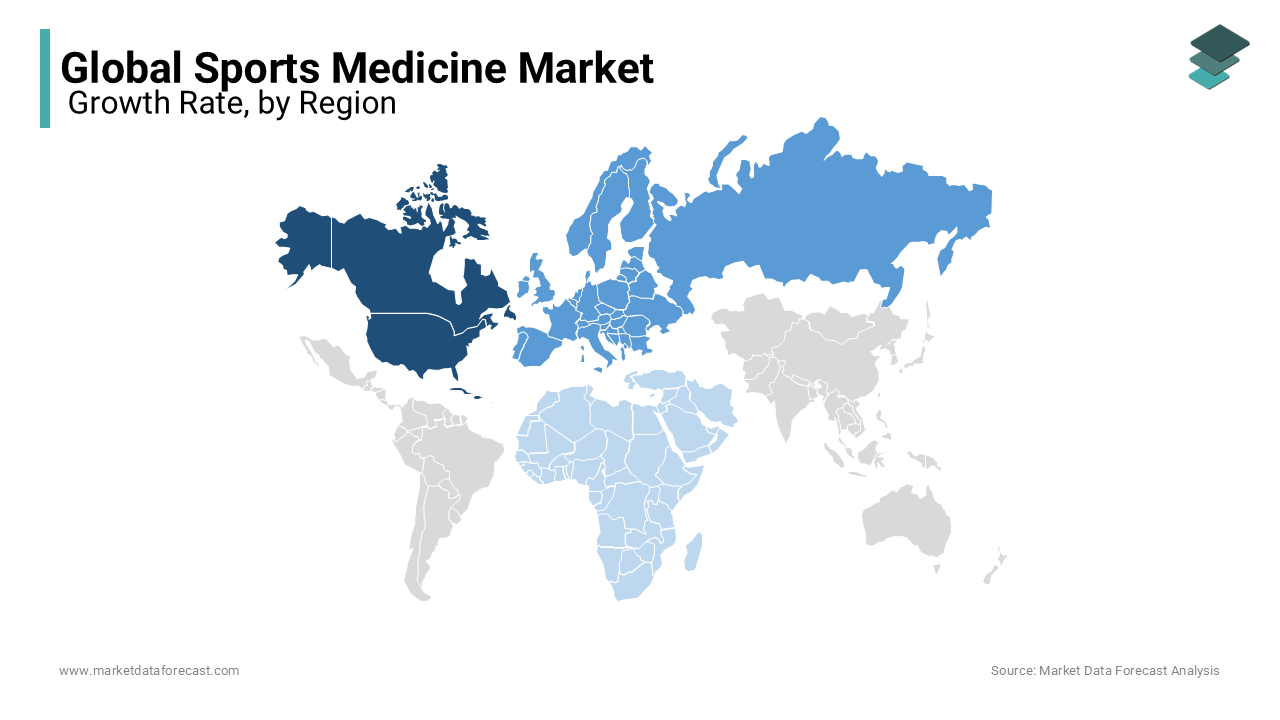Global Sports Medicine Market Size, Share, Trends & Growth Forecast Report - Segmented By Product (Reconstruction and Repair Products, Support & Recovery Products, Accessories), Application (Head Injuries, Shoulder Injuries, Elbow and Wrist Injuries, Back and Spine Injuries, Hip and Groin Injuries, Knee Injuries and Foot and Ankle Injuries) and Region (North America, Europe, Asia Pacific, Latin America, and Middle East & Africa) - Industry Analysis From 2025 to 2033
Global Sports Medicine Market Size
The sports medicine market size was valued at USD 9.86 billion in 2024. The global sports medicine market size is forecasted to value USD 19.88 billion by 2033 from USD 10.66 billion in 2025, growing at a CAGR of 8.1% during the forecast period. The number of sports injuries worldwide primarily accelerates global sports medicine market growth.

Football/Soccer, Basketball, Baseball, Volleyball, Wrestling, Water sports, Cricket, Ice hockey, Rugby, and Bicycling are causing most sports injuries worldwide. As per Livewell, Patellofemoral Syndrome (knee), Shoulder Injury, Tennis or Golf Elbow, Hamstring Strain (thigh), Sciatica (feet), Shin Splints (lower leg bone), Groin Pull (thigh), Concussion (brain), ACL Tear or Strain (ligament of the knee) and Hip Flexor Strain (thigh) are the most common injuries in sports. Sports medicines can help prevent, diagnose, and treat sports injuries. Sports medicine aims to provide athletes with information regarding sports injuries, knowledge of sports injury prevention measures, and sports injury treatment and rehabilitation. Sports pharmaceuticals target all professionals involved in improving the performance and health of sports activists.
MARKET DRIVERS
The growing number of sports-related injuries and technological advancements in treatment procedures drive growth in the global sports medicine market.
An increasing number of casualties in sports, technological advances in sports medicine equipment, increased government budget allocations in the sports sector, and the penetration of key players into emerging markets are some of the significant factors promoting the growth of the global sports medicine market. In addition, private and government organizations' growing focus on developing sports infrastructure and increasing scholarships and corporate funds for athletes help the sports medicine market grow. As a result, the prevalence of sports injuries in the Asia Pacific region is high. For instance, at the 2010 Guangzhou Summer Asian Games, 430 athletes reported 725 casualties. On the other hand, 288 of the 209 athletes started fresh, with 45.5 injuries per 1,000 athletes. In Australia, football is the most competitive sport, with more than 3,000 athletes in the hospitals between 2011 and 2012. At the same time, more than 36,000 Australians over 15 years were hospitalized due to sports injuries. Therefore, this region's high incidence of sports injuries is likely to boost the Australian sports medicine market.
The rapid adoption of technological advancements in developing effective sports medicine from pharmaceutical industries is boosting the sports medicine market growth.
The continually rising rate of injuries and accidents is putting pressure on pharmaceutical companies to manufacture advanced therapies and medical devices. 3D implants are one of the innovations that have emerged from this pressure and are being used as part of sports medicine. In addition, emerging economies of countries like the United States, China, the United Kingdom, India, the U.A.E, and others provide lucrative opportunities for the growth of the global sports medicine market. The growth in the participation levels of sports and physical activities from people, increasing awareness among people and healthcare providers regarding sports medicine, and rising funding to do R&D activities around sports medicine are propelling the sports medicine market growth.
Furthermore, factors such as the increasing healthcare expenditure, growing demand for regenerative medicine, rising popularity and increasing participation in sports by people in several countries, growing patient population suffering from obesity and rising interest in fitness and wellness boost the growth rate of the sports medicine market. The growing demand for wearable medical devices, rising emphasis on preventative care, increasing awareness of sports tourism and growing demand for physical therapy further support the sports medicine market growth.
MARKET RESTRAINTS
High costs associated with sports medicine products and services are one of the key factors hampering the market growth.
Due to these high costs, the affordability and accessibility of sports medicine are being limited only to people who have the purchasing capacity. Unfavorable insurance coverage for sports medicine products and services in some countries hinders market growth. The lack of favorable reimbursement policies for sports medicine products and services in some countries hinders market growth. In addition, factors such as poor access to healthcare in some countries, the scarcity of skilled healthcare professionals and limited awareness of sports medicine products and services among people impede the market growth. Furthermore, the stringent regulatory environment for sports medicine, the competition for sports medicine from alternative therapies and limited funding for the R&D of sports medicine inhibit the market’s growth rate.
REPORT COVERAGE
|
REPORT METRIC |
DETAILS |
|
Market Size Available |
2024 to 2033 |
|
Base Year |
2024 |
|
Forecast Period |
2025 to 2033 |
|
Segments Covered |
By Product, Application, and Region |
|
Various Analyses Covered |
Global, Regional & Country Level Analysis, Segment-Level Analysis; DROC, PESTLE Analysis, Porter's Five Forces Analysis, Competitive Landscape, Analyst Overview of Investment Opportunities |
|
Regions Covered |
North America, Europe, APAC, Latin America, Middle East & Africa |
|
Market Leader Profiled |
Smith & Nephew PLC, Arthrex, Inc., össur hf, Stryker Corporation, Conmed Corporation, Zimmer Biomet Holdings, Inc., Breg, Inc., Mueller Sports Medicine, Inc., Tornier, Inc., Skins International Trading AG, Wright Medical Technology, Inc. |
SEGMENTAL ANALYSIS
By Product Insights
The reconstruction and repair segment is anticipated to lead the market and hold a leading share of the global sports medicine market during the forecast period owing to the growing awareness of sports injuries. This segment is estimated to be witnessing a CAGR of 7.1% during the forecast period. In addition, the increasing usage of implants, fracture, and ligament repair products in treatment procedures drives segmental growth. Under the sub-segments, the arthroscopy devices segment is predicted to witness the fastest CAGR during the forecast period. The growing adoption of minimally invasive surgeries and an increasing number of technological developments in arthroscopic technology primarily boost the segment’s growth rate.

The support and recovery product segment is projected to have a healthy CAGR during the forecast period. Under the sub-segments, the braces and support segment accounted for a substantial share of the sports medicine market in 2023 and is expected to register a healthy CAGR in the coming years. The growing incidence of sports injuries is primarily driving the growth of the braces and support segment. As per the data published by the American Academy of Orthopaedic Surgeons (AAOS), 10% of all emergency department visits in hospitals in the United States are related to sports-related injuries yearly. In addition, factors such as rising awareness among people regarding sports injuries and an increasingly aging population are propelling segmental growth. The growing usage of material technology and advanced materials such as neoprene, nylon, and spandex to manufacture effective, durable braces and support products that are also lightweight and comfortable is predicted to boost the segment’s growth rate.
By Application Insights
The knee injuries segment was the market leader in 2023 and will continue its dominating trend throughout the forecast period. The high possibility of meeting knee injuries in most sports and the rising adoption of minimally invasive surgeries in treatment procedures drive the growth of this segment. According to the data published by the American Academy of Orthopaedic Surgeons (AAOS), an estimated 3.7 million knee injuries are reported in the United States each year. In addition, the growing participation of people in high-impact sports such as basketball, football and soccer, increasing adoption of knee surgery techniques such as minimally invasive surgery and computer-assisted surgery, increasing aging population worldwide and rising awareness about knee injury prevention and management further fuel the growth rate of the segment.
REGIONAL ANALYSIS

Geographically, the North American sports medicine market was the biggest regional segment worldwide in 2023 and is expected to continue showing domination throughout the forecast period. The growth of the North American market is driven by the rising prevalence of sports injuries, increasing participation of people in sports activities and availability of advanced healthcare infrastructure. The growing investments by the market participants of North America on the R&D of sports medicine to bring new and effective products to the market to address the growing demand which is expected to accelerate the market growth in the North American region during the forecast period. The rising awareness among people regarding preventative measures and fitness regimens among the North American population boosts regional market growth. In addition, increasing healthcare spending, the availability of technologically well-advanced devices in healthcare facilities, favorable reimbursement policies and insurance coverage for sports-related injuries further fuel the growth rate of the North American market. The U.S. accounted for the largest share of the North American market in 2023 and the U.S. market is expected to grow promisingly during the forecast period. An increasing number of patients visiting hospitals with sports-related injuries in the United States is driving the U.S. market. As per the data published by the Centers for Disease Control and Prevention (CDC), the number of sports injuries treated in emergency departments rose by 16% between 2001 and 2018. As per the estimates of the American Academy of Orthopaedic Surgeons (AAOS), an estimated 8.6 million sports injuries are recorded in the U.S. every year.
Europe is a potential market for sports medicine and accounted for the second biggest share of the global market in 2023. During the forecast period, the European sports medicine market is predicted to record a notable CAGR. The growth of the European market is majorly fuelled by factors such as increasing awareness among the European population regarding the importance of engaging in physical activity and sports to stay fit and healthy, rising incidence of sports-related injuries and the growing aging population participating in sports activities. As per the statistics published by the European Commission, more than 45% of adults in the European Union participate in sports and physical activities at least once a week. An estimated 2.5 million sports-related injuries are being recorded per year in the European region, as per the estimates of the European Association for Sports Medicine. In addition, the presence of advanced healthcare infrastructure, favorable reimbursement policies for sports medicine and the availability of skilled healthcare professionals in Europe further fuel the growth rate of the European sports medicine market. Furthermore, a growing number of initiatives by the governments of Europe to promote sports participation among people, increasing adoption of sports performance-enhancing products and services by athletes in Europe and an increasing number of investments for the research and development of sports medicine by the key market participants propel the growth rate of the European market.
The Asia-Pacific region is a lucrative regional market for sports medicine. The APAC sports medicine market is predicted to register the fastest CAGR worldwide during the forecast period. The increasing incidence of sports injuries, growing number of sports and fitness enthusiasts, rising health awareness and the presence of a large young population highly interested in sports and fitness activities in the APAC countries accelerate the sports medicine market growth in the Asia-Pacific region. According to the Asian Journal of Sports Medicine, the incidence of sports injuries is comparatively higher than the other regions due to various reasons such as climate, terrain, and culture. As per the data published by the Journal of Clinical Orthopaedics and Trauma, the prevalence of sports injuries in India is expected to be approximately 40%. The growing number of improvements in the healthcare infrastructure and the presence of numerous skilled professionals in the APAC countries further contribute to the growth of the sports medicine market in APAC. The rapidly growing middle-class population with increasing disposable income and interest in sports and fitness activities, increasing urbanization and rising adoption of western lifestyle habits favor the APAC sports medicine market to grow further. Favorable government policies and numerous manufacturers of sports medicine in the APAC countries drive the sports medicine market growth in the Asia-Pacific region.
The Latin American sports medicine market is projected to hold a considerable share of the global market in the coming years owing to the growing number of sporting activities from Brazil, Mexico, Argentina, and Chile. The growing improvements in the medical infrastructure in Latin American countries and the rising adoption of preventative healthcare drive the Latin American market growth. As per the data published by the Pan American Healthcare Organization, lack of physical activity is one of the major factors leading to the incidence of chronic diseases in Latin America and this factor is expected to result in the growing usage of sports medicine and act as a key component in the preventative healthcare in the Latin American region.
The sports medicine market in MEA is estimated to have a steady CAGR in the coming years. The growing sports tourism and major sporting events hosted in the countries of the Middle East and Africa, rising emphasis on wellness activities and growing demand for sports medicine products and services drive the market growth in MEA. According to the Journal of Sports Medicine and Physical Fitness, the incidence of sports injuries among football players in Egypt was almost 47%.
KEY MARKET PLAYERS
Noteworthy companies leading the global sports medicine market profiled in this report are Smith & Nephew PLC, Arthrex, Inc., össur hf, Stryker Corporation, Conmed Corporation, Zimmer Biomet Holdings, Inc., Breg, Inc., Mueller Sports Medicine, Inc., Tornier, Inc., Skins International Trading AG, Wright Medical Technology, Inc., DePuy Mitek, Inc., 3M Company Ace Brand, OttoBock Healthcare GmbH and DJO Global, Inc.
Key market participants invest hugely in Research and Development to create innovative and effective solutions for sports injuries. For instance, Nova Scotia's performance-based company, Athletigen Technology, Inc., has worked with various athletes to use information gathered in DNA to improve performance and reduce the incidence of sports-related injuries. The initiatives mentioned above by various companies are to drive market growth during the forecast period.
RECENT MARKET HAPPENINGS
- In June 2020, Smith+Nephew made a public statement by launching its new INTELLIO-connected Tower Solution, which connects wirelessly and controls multiple sports medicine systems outside the sterile field.
- In June 2020, DJO introduced the new DonJoy X-ROM Post-Op Knee Brace. It is designed to improve user-friendly for quick and simple application and adjustment. In addition, this X-ROM brace helps patients recover from ACL repair and other knee-related surgeries with better confidence, comfort, and stability.
- In October 2019, DePuy Synthes (J&J Medical Devices), a well-known sports medicine brand, expanded its hip implant portfolio by joining JointPoint, Inc.
- Leomo Inc. has partnered with biomechanics and sports medicine research institutes to test its product to treat injuries in triathletes, cyclists, and coaches.
- In February 2017, Leaf Healthcare collaborated with Smith & Nephew PLC to expand its customer base.
- In March 2019, Arthrex offered internships and scholarships for students who have taken courses related to surgical treatments at Clemson University.
- In March 2017, DePuy Synthes Mitek Sports Medicine introduced a new suite of knee arthroscopy solutions to improve operating room efficiency and simplify ACL and meniscus repair, making these surgeries easier.
MARKET SEGMENTATION
This research report on the global sports medicine market has segmented & sub-segmented the market based on the product, application, and region.
By Product
- Reconstruction and Repair
- Implants
- Prosthetics
- Arthroscopy Devices
- Fracture and Ligament Repair Products
- Orthobiologics
- Support and Recovery
- Braces and Support
- Thermal Therapy Products
- Topical Pain Relief Products
- Compression Clothing
- Monitoring Devices
- Other Body Support and Recovery Products
- Accessories
By Application
- Head Injuries
- Shoulder Injuries
- Elbow and Wrist Injuries
- Back and Spine Injuries
- Hip and Groin Injuries
- Knee Injuries
- Foot and Ankle Injuries
By Region
- North America
- Europe
- Asia Pacific
- Latin America
- The Middle East and Africa
Frequently Asked Questions
Does this report include the impact of COVID-19 on the sports medicine market?
Yes, we have studied and included the COVID-19 impact on the global sports medicine market in this report.
Which segment by product type led the sports medicine market in 2024?
By Product Type, the Reconstruction and repair segment led the sports medicine market in 2024.
Which are the major players operating in the sports medicine market?
Smith & Nephew PLC, Arthrex, Inc., össur hf, Stryker Corporation, Conmed Corporation, Zimmer Biomet Holdings, Inc., Breg, Inc., Mueller Sports Medicine, Inc., Tornier, Inc., Skins International Trading AG, Wright Medical Technology, Inc., DePuy Mitek, Inc., 3M Company Ace Brand, OttoBock Healthcare GmbH and DJO Global, Inc. are some of the prominent companies in the global sports medicine market.
Related Reports
Access the study in MULTIPLE FORMATS
Purchase options starting from $ 2500
Didn’t find what you’re looking for?
TALK TO OUR ANALYST TEAM
Need something within your budget?
NO WORRIES! WE GOT YOU COVERED!
Call us on: +1 888 702 9696 (U.S Toll Free)
Write to us: [email protected]
